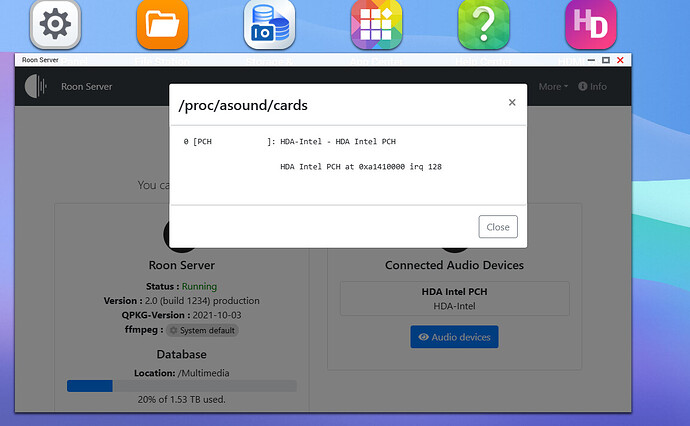Here’s the audio device list from the NAS:
You would need to connect to the QNAP in a terminal by ssh as described here:
Then, after you are in the Console Management and press Q and Y as described there, you are on the QNAP terminal (text shell). Then type
aplay -l
and press Enter
I got in to console:
[~] # aplay -l
**** List of PLAYBACK Hardware Devices ****
ALSA lib control.c:953:(snd_ctl_open_noupdate) Invalid CTL hw:0
aplay: device_list:277: control open (0): No such file or directory
[~] #
Hm. This might be turning into a question for QNAP.
Are you handy on the command line? When you are in the ssh window on the QNAP, check if there is a file /usr/share/alsa/alsa.conf
You can run the command:
cat /usr/share/alsa/alsa.conf
This probably should either output the content of this text configuration file or else say that the file does not exist. But I don’t know for sure, it’s a long time that I have poked around in the OS of my QNAP and have no time to try right now, but the file path might possibly differ on the QNAP, depending on their file system layout.
There is someone here on this page with the same error who is trying to bring up ALSA on an embedded device and apparently the alsa.conf file and a few others are required to exist in the configuration directory, which normally is /usr/share/alsa/:
Its there but I have not idea what it really means.
[~] # cat /usr/share/alsa/alsa.conf
pcm.bluetooth {
@args [ ADDRESS ]
@args.ADDRESS {
type string
}
type plug
slave {
pcm {
type bluetooth
device $ADDRESS
mode stereo
}
}
}
[~] #
Back to my statement about using a chromecast dongle, its only going to support a sample rate of 96KHz/24bit lossless so that’s really not a solution to gain the full hires scale.
There is a Roon extension for Heos that will bridge Heos/UPnP to Roon I would look at that as an option. Search in tinkering you will find out about it.
Seems funky to me because it only seems to define BT
Here’s a generic example, I think
And some context here:
https://www.alsa-project.org/wiki/Asoundrc
But I think this is becoming a thing best asked to QNAP and it’s been ages that I interacted with ALSA directly
Probably @crieke knows what’s going on with ALSA on QNAP in this case here?
no worries, thanks for the assistance. I did see someone above replied with a HEOS/Roon extension. Maybe thats the way to go…
ok, thanks.
I don’t see it in my roon GIU on the desktop but I’ll look into it.
You have to instal Roon extension manager and then use that to install the extension. You should be able to run extension manager on the NAS.
I don’t see Roon extension manager under downloads. My QNAP NAS just has core running.Can the extension manager be installed on the desktop where the GUI is installed?
Not really Look up extension manager it only runs on Linux there is a docker install for it that you can run on a NAS. It’s not made by Roon it’s a 3rd party community thing as all extensions are. Then you enable the extension manage in extensions and it gives you access to easy install other extensions. No Roon extensions are plug and play really they rely on lots of different components so extension manager itself an extension makes it easier to set them up.
Wow, so much open source. Wonder how secure this stuff is.
Open source or not is not a measure for that
Sorry its just confusing…
How do you configure/use the Marantz AV10? Before you dive down a high resolution rabbit hole, know that most A/V components internally down convert higher sample rates to 48 kHz in many common use cases.
AJ
I can stream from my NAS to the AV10 192/24 using built-in HEOS or the HEOS app on mobile device without a problem.
RHEOS will stream at 192/24 if set to hi res for the device.
Should sound great with the AV10. I love the marantz sound but was so disappointed with only AirPlay connectivity to ROON if you don’t wire directly … and then no control of volume.
Would love to hear how it works if you go down this route.
By the way - open source is a good way to go for security as it’s “open” and the code easily reviewed compared to closed systems.
UPnP has some known risks but for most of us they are largely theoretical and the benefit outweighs the risk in my case.
